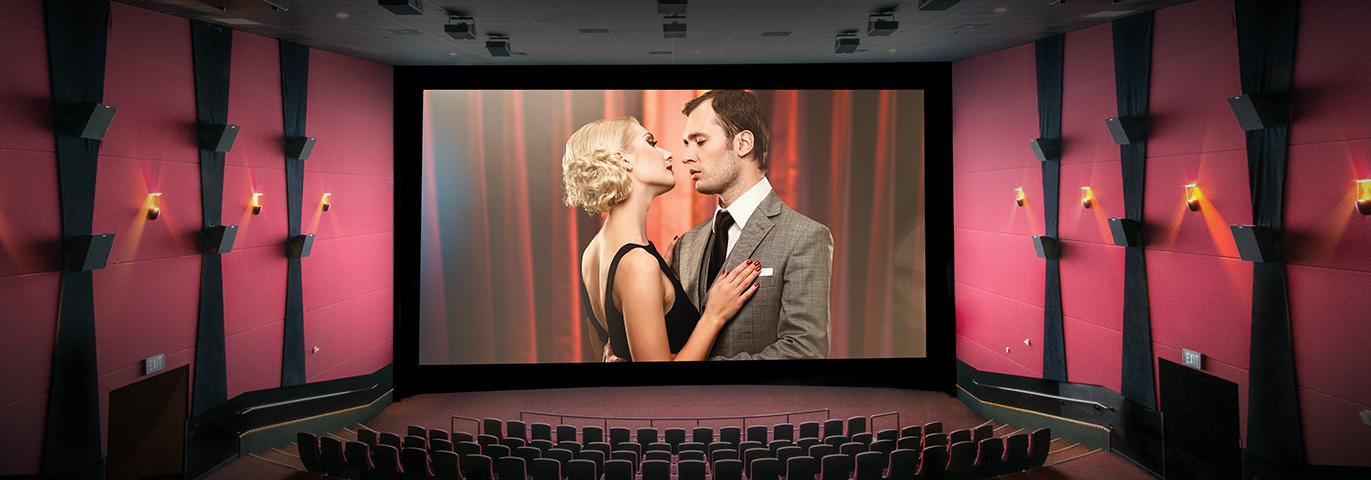One thing that sets cinema sound apart from almost all other types of professional audio is that the goal for cinema playback is to be heard as much like the original recording as possible. This is significant, and not trivial. Filmmakers quite literally want you to experience their work as they saw it and heard it when they approved the final masters.
Properly designed cinema sound systems follow well-established industry standards to match what is heard in post-production. This, along with proper design calibration of cinema loudspeakers, allows you to achieve a highly accurate translation of the original artistic intent of the director and sound mixer.

Cinema Sound
Most cinemas have three loudspeakers mounted behind the perforated cinema screen (Left, Center and Right). These are referred to as (you guessed it) “screen channels”. They have very specific requirements/features, performance goals, and form factors that are quite different than typical pro audio loudspeakers.

The QSC Digital Cinema Series (DCS) SC-223X screen channel loudspeaker is a typical example of a loudspeaker you might find behind the screen at your neighborhood multiplex.
In contrast, the QSC AP-5152 is a high-power, 1 x 15” 2-way pro audio loudspeaker designed for installation in a variety of AV applications such as bars, restaurants, and music venues. Its compact design includes a large format HF driver that is also used in many of our cinema screen channels. It has a trapezoidal shape, a grille, and birch plywood construction with M10 mounting points to facilitate a variety of mounting methods. Its compact size, reasonable weight and high output make it ideal for AV applications (but not for cinema).
The Design
Cinema screen channels are designed to be full range. But, unlike many pro audio loudspeakers, they do not cross over to a subwoofer. The subwoofer in a cinema application receives a separate recorded track, and it’s not normally used to reproduce very low frequency content from the Left, Center and Right screen channels. However, due to the need to play low frequencies, screen channel loudspeakers normally utilize two, three or even four 15” subwoofers in their LF sections.
The large number of loudspeakers required in a cinema multiplex make cost a critical aspect when selecting the right loudspeaker. Therefore, you’ll notice cinema screen channels leave off several features you typically find in pro audio loudspeakers.
For example, there are no handles or grilles. The paint is flat black to prevent reflections of light back through the perforated screen, and connectors are typically screw-type barrier strips instead of “speakON” or other quick connect/disconnect types.
Since cinema loudspeakers don’t need to be portable, and height and width are not usually an issue, the low frequency cabinets can be very large in cubic volume compared to pro audio loudspeakers. This improves efficiency and extension at the very lowest frequencies, at the expense however, of overall sensitivity. The horns can be very large as well.
In terms of cabinet construction, cinema cabinets are typically built using MDF (medium-density fiberboard) instead of the expensive birch plywood that make pro audio loudspeakers light enough to be suspended overhead and portable. Also, the midrange and high frequency horns and drivers of a screen channel are not enclosed at the rear, saving the cost of a full cabinet.
Let’s Talk About the Horn
The biggest difference in configuration for cinema loudspeakers is the need to have excellent dialog intelligibility. To achieve this, the large midrange horn allows for pattern control down to lower frequencies than a smaller pro audio system, and keeps most of the dialog range in between the crossover points of the midrange horn.

For example, the AP-5152 HF horn’s 75° conical coverage angle is well matched to the coverage pattern of its single 15” subwoofer with the crossover frequency of about 1 kHz. In order to maintain a uniform coverage pattern below 1 kHz, the horn would have to be larger. To accommodate that, the cinema midrange horn is about twice as wide as the AP-5152 horn, which allows pattern control to extend about one octave lower, or down to 500-600 Hz.
To lower the pattern control limit to half the frequency, the horn should be twice as wide. The dual 15” stacked woofers of many QSC screen channel models have a good coverage pattern match to the 90°x50°horn down to about 300 Hz. The three-way cinema loudspeaker crosses over at about 300 Hz and 2 kHz to allow for most of the vocal range to be reproduced by the large midrange horn. This results in exceptional dialog intelligibility, even in the back of the room.
The QSC Difference
QSC cinema screen channels are optimized for the typical multiplex auditorium, resulting in not only incredible sound, but ease of installation and aiming as well. When combined with Intrinsic Correction™ DSP presets provided by QSC processing, it is possible to achieve unmatched audio performance with very little additional EQ on site. This saves you both valuable tech time and money.
Have you tried them? Do you have any questions or want more details? Check out our website for more details about QSC Screen Channel loudspeakers here and let us know what you think in the comments section below. We look forward to hearing from you. And remember, we’re here for you when you need us.

I keep listening to the reports speak about receiving boundless online grant applications so I have been looking around for the top site to get one. Could you advise me please, where could i find some?
708467 116547Normally I do not read article on blogs, but I wish to say that this write-up quite forced me to try and do so! Your writing style has been surprised me. Thanks, quite nice post. 260987